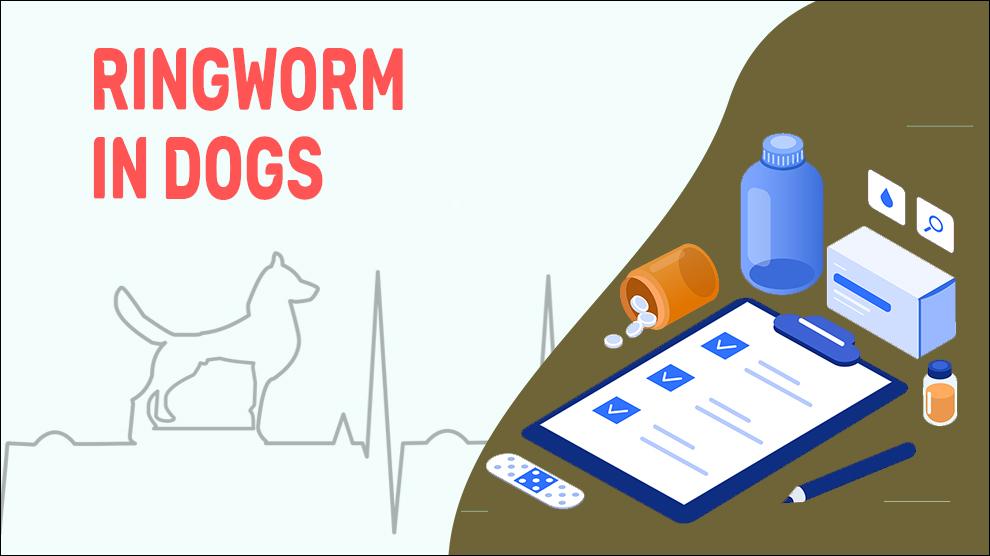What Is Ringworm In Dogs?
Ringworm is a common term for dermatophytosis, a fungal infection of the skin that causes circular areas of alopecia, redness, and scaly sores in the skin. There are, in fact, 40 different types of fungi that can cause ringworm. The main culprit for ringworm in dogs is mold-like fungi called Microsporum Canis (80%) and other prominent fungi that cause ringworm Microsporum Gypseum, and Trichophyton Mentagrophytes.
This is a zoonotic disease, which means that it can spread between dogs and humans. Regardless of its name, a ringworm is not actually a parasite or worm of any kind. The reason it got this name is that the fungus causes circular, raised, ring-shaped skin rashes that appear worm-like, especially noticeable on regions of thin hair coverage.
Infected dogs manifest scaly patches with broken hairs or become bald with a crusty covering. Sometimes, acne-like bumps are also developed on the skin. The most common locations affected by ringworm are the superficial layers of the face, ear tips, feet, and tail. Most commonly, ringworm is spread by exposure to affected animals or infected things such as grooming or furniture, or toys. Spores associated with broken hairs are the main sources of the disease spread. However, proximity does not always bring about infection.
The establishment of infection depends on host factors and on the fungal species, including health, age, condition of surface exposed, nutrition, and grooming behavior. Ringworm Infection initiates short-term resistance to re-infection. Sometimes, dermatophytes develop only in the dead tissues of hair and skin, and infection cannot reach inflamed tissues or living cells. An increase in host immunity and inflammation results in stopping the infection spread, however, this course may take a few weeks.
Symptoms Of Ringworm In Dogs
- Alopecia or Hair loss in the affected area in the form of reddened plaques or nodules
- Excessive licking of skin in one spot
- Itchiness
- Eroded or ulcerated skin
- Scabbing or moistness
- Hyperpigmentation
Treatment Options For Ringworm In Dogs
Topical treatments:
Clotrimazole (Otibiotic or Otomax) miconazole (Micaved) or terbinafine (Lamisil)
Miconazole-based shampoo + Chlorhexidine or a sulfurated lime solution such as lime-sulfur dip that can be used twice weekly
Oral treatments:
Griseofulvin (Gris-Peg, Fulvicin, Grisovin)
Itraconazole (Sporanox, Itrafungol,Onmel)
Terbinafine (Lamisil)
Home Remedies For Ringworm In Dogs
- Clipping the hair of an infected dog with its careful disposal is very important.
- Bandages, Shirts or sleeves, muzzles, and E-collars may prevent the dog from licking or chewing the sore.
How To Prevent Ringworm In Dogs?
- Keeping the home environment free from spores is very important. Significant tick infestation in the surrounding can only be prevented by outdoor garden treatments like environmentally safe deterrents and tick sprays.
- To reduce environmental contamination, topical antifungal treatment of affected areas of skin should be used in combination with Clipping of hairs.
- Try to remove pet hairs from furniture or floors, as they may be contaminated with fungal spores.
- Never allow your dog to roam freely in tick-infested areas, wooded /grassy areas, and moist, shady areas.
- Always use medicated shampoos once a week. After applying shampoo, leave it for 5 minutes and rinse it completely. Be careful to avoid the eyes, mouth, and nose.
Affected Dog Breeds Of Ringworm
Akita, Boxer, Doberman Pinscher, Dalmatian, English Setter, Golden Retriever, Great Dane, Labrador Retriever, Irish Setter, Weimaraner, Shar Pei, Boston Terrier, Yorkshire Terrier, Jack Russell Terrier
Causes, Diagnosis, And Prognosis For Ringworm In Dogs
1. Cause:
- When coming in contact with contaminated items can spread ringworm (dog bowls, combs, toys, furniture, bedding)
- Direct transmission of the fungus through other infected animals or person
- Warm moist soils can store ringworm spores
- Fleas
- Immunocompromised dogs and humans
2. Mortality:
Mortality associated with ringworm is not yet documented
3. Diagnosis:
- Skin testing / Dermatophyte testing
- Fluorescence of infected hairs- wood’s lamp
- Culture to check ringworm
- Fine needle aspiration/ Skin biopsy to rule out skin cancer
- Food-elimination test for food allergies/ Allergy testing for
4. Prognosis:
Early diagnosis and prompt treatment for the dogs are the ways to a better prognosis.
Never skip Regular health checks to make sure there are no secondary infections.
When To See A Vet For Ringworm In Dogs?
Contact your vetright away, if you notice:
- Alopecia/ulcerated skin with nodules or reddened plaques
- Compulsive licking of parts of the body
Food Suggestions For Ringworm In Dogs
- Cooked ground turkey/lean cooked chicken with whole grains (such as brown rice)
- Cook skinless chicken breast + brown rice + chopped sweet potatoes + chopped tomatoes + dried parsley
- Frozen veggie blends that contain carrots, corn, green beans, and peas
- Eggs, carrots, chia seeds, peanut butter, oatmeal, sweet potatoes
- Protein, such as lean beef, chicken, fish, turkey
Conclusion
Don’t worry if you see regions of hair loss get increase after treatment has started. The patches will reduce in size after 2-3 weeks, and the hair should start to grow back. Sometimes, treatment has to be evaluated often to stop relapse. The prognosis is excellent when it is diagnosed early.

















